sensor Citroen C3 PICASSO RHD 2016 1.G Owner's Manual
[x] Cancel search | Manufacturer: CITROEN, Model Year: 2016, Model line: C3 PICASSO RHD, Model: Citroen C3 PICASSO RHD 2016 1.GPages: 296, PDF Size: 9.13 MB
Page 5 of 296
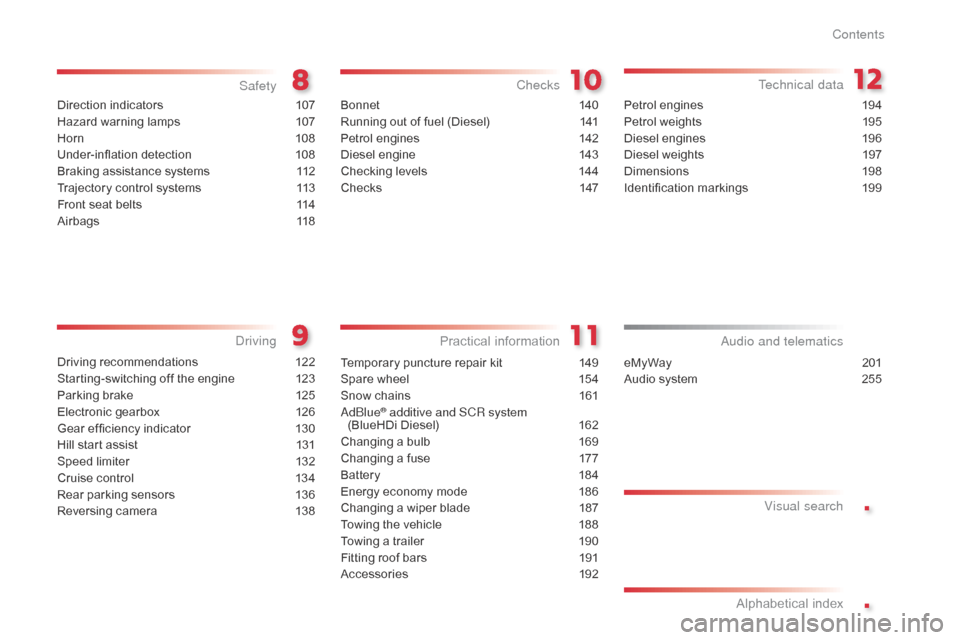
.
.
Direction indicators 107
Hazard warning lamps
1
07
Horn
10
8
Under-inflation detection
1
08
Braking assistance systems
1
12
Trajectory control systems
1
13
Front seat belts
1
14
Airbags
1
18
Safety
Driving recommendations 122
Starting-switching off the engine
1
23
Parking brake
1
25
Electronic gearbox
1
26
Gear ef ficiency indicator
1
30
Hill start assist
1
31
Speed limiter
1
32
Cruise control
1
34
Rear parking sensors
1
36
Reversing camera
1
38
Driving
eMyWay 2 01
Audio system
2
55
Audio and telematics
Alphabetical index Visual search
Bonnet 14
0
Running out of fuel (Diesel)
1
41
Petrol engines
1
42
Diesel engine
1
43
Checking levels
1
44
Checks
14
7
Checks
Temporary puncture repair kit 149
Spare wheel
1
54
Snow chains
1
61
AdBlue
® additive and SCR system
(BlueHDi Diesel) 1 62
Changing a bulb
1
69
Changing a fuse
1
77
Battery
1
84
Energy economy mode
1
86
Changing a wiper blade
1
87
Towing the vehicle
1
88
Towing a trailer
1
90
Fitting roof bars
1
91
Accessories
1
92
Practical information Technical data
Petrol engines 1
94
Petrol weights
1
95
Diesel engines
1
96
Diesel weights
1
97
Dimensions
1
98
Identification markings
1
99
Contents
Page 6 of 296

4
Guide-me-home lighting
After switching off the ignition, the headlamps remain on briefly to make your exit from
the vehicle easier when the light is poor.
ASR and DSC systems
These systems are linked to assure the
directional stability of the vehicle within the
limits of the laws of physics.
Panoramic glass sunroof
This roof provides incomparable visibility and
light in the passenger compartment.
Rear parking sensors / reversing camera
These two systems warn you if an obstacle is detected behind the vehicle
when reversing.113
Exterior
136 / 138 67
74
Over view
Page 9 of 296
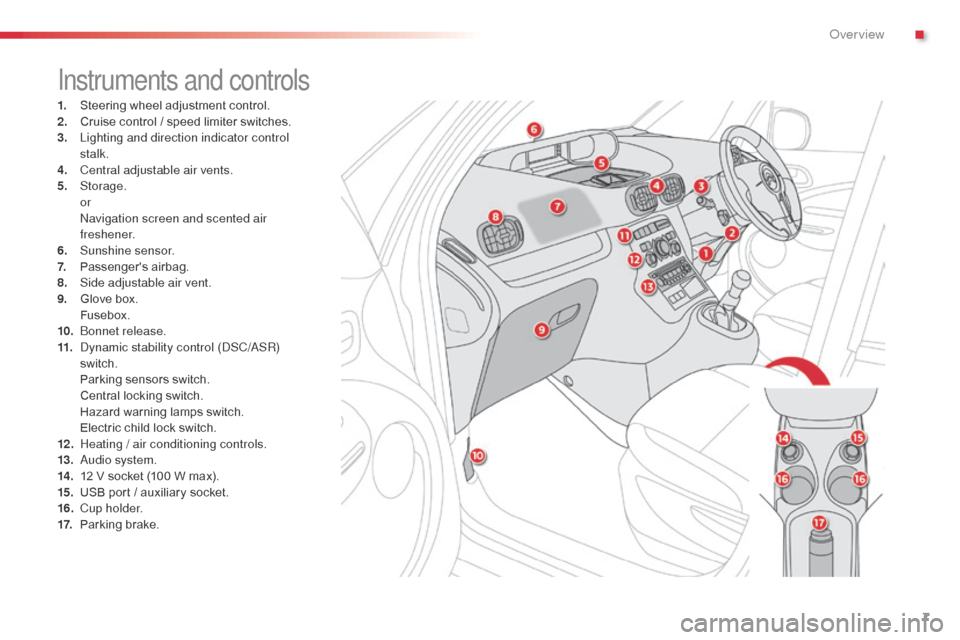
7
Instruments and controls
1. Steering wheel adjustment control.
2. Cruise control / speed limiter switches.
3.
L
ighting and direction indicator control
stalk.
4.
C
entral adjustable air vents.
5.
Storage.
or
N
avigation screen and scented air
freshener.
6.
S
unshine sensor.
7.
P
assenger's airbag.
8.
S
ide adjustable air vent.
9.
G
love box.
F
usebox.
10.
B
onnet release.
11.
D
ynamic stability control (DSC/ASR)
switch.
P
arking sensors switch.
C
entral locking switch.
H
azard warning lamps switch.
E
lectric child lock switch.
12 .
H
eating / air conditioning controls.
13.
A
udio system.
14 .
1
2 V socket (100 W max).
15.
U
SB port / auxiliary socket.
16.
C
u p h o l d e r.
17.
P
arking brake.
.
Over view
Page 34 of 296
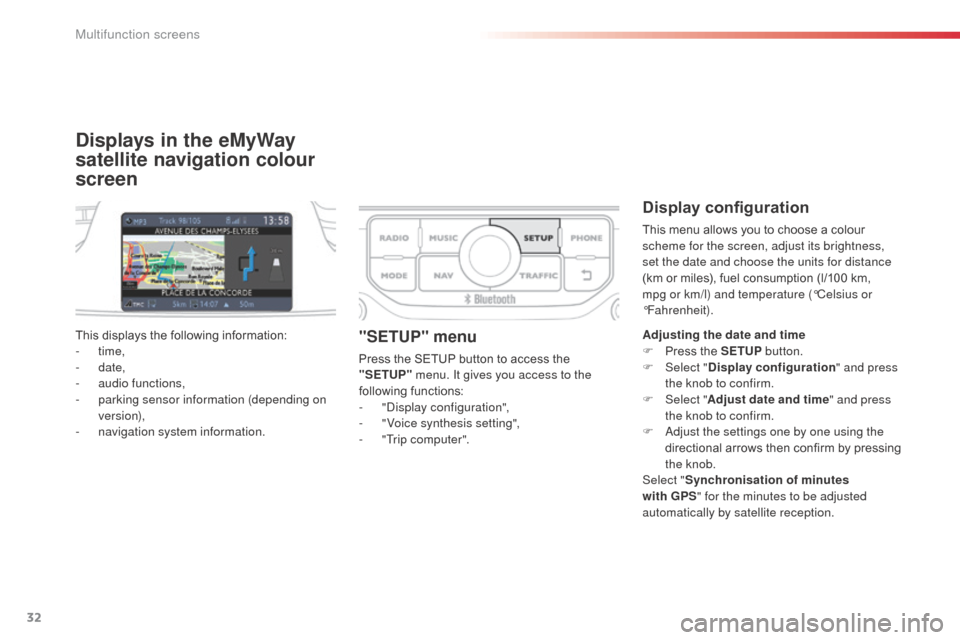
32
Displays in the eMyWay
satellite navigation colour
screen
Display configuration
This menu allows you to choose a colour
scheme for the screen, adjust its brightness,
set the date and choose the units for distance
(km or miles), fuel consumption (l/100 km,
mpg or km/l) and temperature (°Celsius or
°Fahrenheit).
This displays the following information:
-
time,
-
date,
-
a
udio functions,
-
p
arking sensor information (depending on
version),
-
n
avigation system information.
"SETUP" menu
Press the SETUP button to access the
"SETUP" menu. It gives you access to the
following functions:
-
"
Display configuration",
-
"
Voice synthesis setting",
-
"
Trip computer". Adjusting the date and time
F
P ress the SETUP
button.
F Sel ect "Display configuration " and press
the knob to confirm.
F
Sel
ect "Adjust date and time " and press
the knob to confirm.
F
A
djust the settings one by one using the
directional arrows then confirm by pressing
the knob.
Select " Synchronisation of minutes
with GPS " for the minutes to be adjusted
automatically by satellite reception.
Multifunction screens
Page 44 of 296
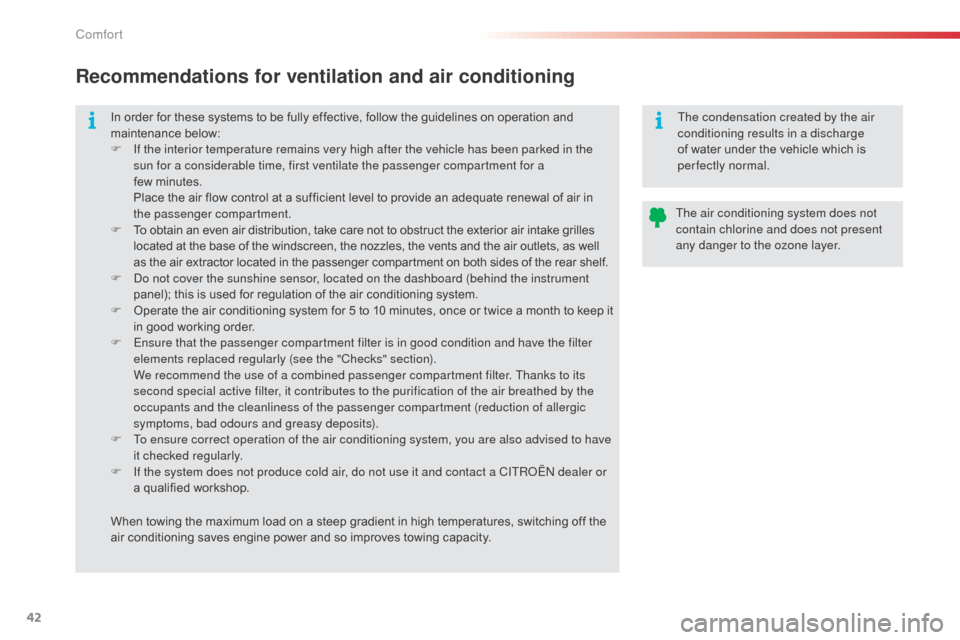
42
In order for these systems to be fully effective, follow the guidelines on operation and
maintenance below:
F
I
f the interior temperature remains very high after the vehicle has been parked in the
sun for a considerable time, first ventilate the passenger compartment for a
few minutes.
P
lace the air flow control at a sufficient level to provide an adequate renewal of air in
the passenger compartment.
F
T
o obtain an even air distribution, take care not to obstruct the exterior air intake grilles
located at the base of the windscreen, the nozzles, the vents and the air outlets, as well
as the air extractor located in the passenger compartment on both sides of the rear shelf.
F
D
o not cover the sunshine sensor, located on the dashboard (behind the instrument
panel); this is used for regulation of the air conditioning system.
F
O
perate the air conditioning system for 5 to 10 minutes, once or twice a month to keep it
in good working order.
F
E
nsure that the passenger compartment filter is in good condition and have the filter
elements replaced regularly (see the "Checks" section).
W
e recommend the use of a combined passenger compartment filter. Thanks to its
second special active filter, it contributes to the purification of the air breathed by the
occupants and the cleanliness of the passenger compartment (reduction of allergic
symptoms, bad odours and greasy deposits).
F
T
o ensure correct operation of the air conditioning system, you are also advised to have
it checked regularly.
F
I
f the system does not produce cold air, do not use it and contact a CITROËN dealer or
a qualified workshop. The air conditioning system does not
contain chlorine and does not present
any danger to the ozone layer.
When towing the maximum load on a steep gradient in high temperatures, switching off the
air conditioning saves engine power and so improves towing capacity.
Recommendations for ventilation and air conditioning
The condensation created by the air
conditioning results in a discharge
of water under the vehicle which is
perfectly normal.
Comfort
Page 58 of 296
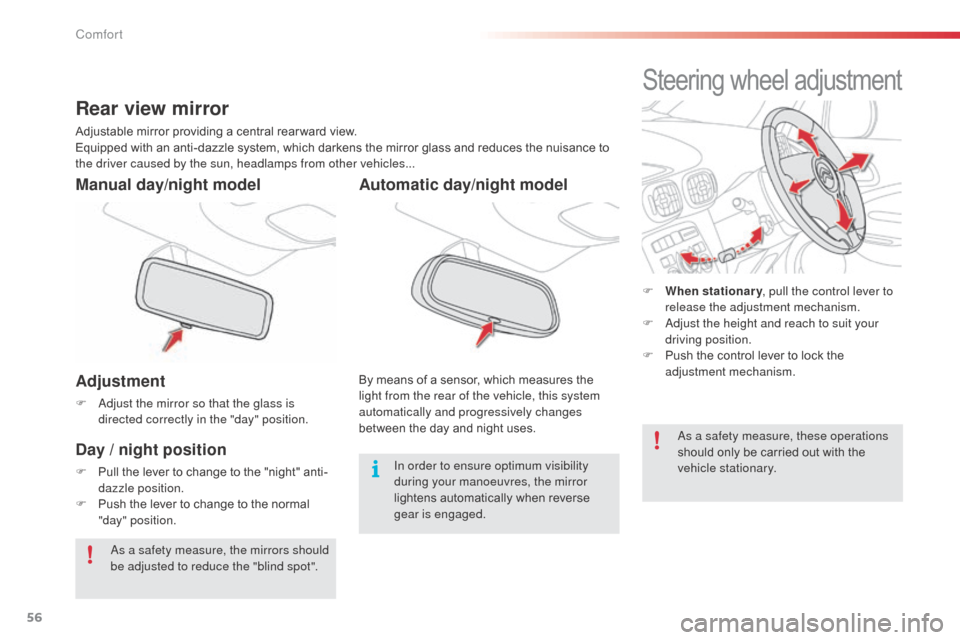
56
Adjustment
F Adjust the mirror so that the glass is directed correctly in the "day" position.
Manual day/night model
Day / night position
F Pull the lever to change to the "night" anti-dazzle position.
F
P
ush the lever to change to the normal
"day" position.
Rear view mirror
Adjustable mirror providing a central rear ward view.
Equipped with an anti-dazzle system, which darkens the mirror glass and reduces the nuisance to
the driver caused by the sun, headlamps from other vehicles...
Steering wheel adjustment
F When stationary , pull the control lever to
release the adjustment mechanism.
F
A
djust the height and reach to suit your
driving position.
F
P
ush the control lever to lock the
adjustment mechanism.
As a safety measure, the mirrors should
be adjusted to reduce the "blind spot". As a safety measure, these operations
should only be carried out with the
vehicle stationary.
Automatic day/night model
By means of a sensor, which measures the
light from the rear of the vehicle, this system
automatically and progressively changes
between the day and night uses.
In order to ensure optimum visibility
during your manoeuvres, the mirror
lightens automatically when reverse
gear is engaged.
Comfort
Page 76 of 296
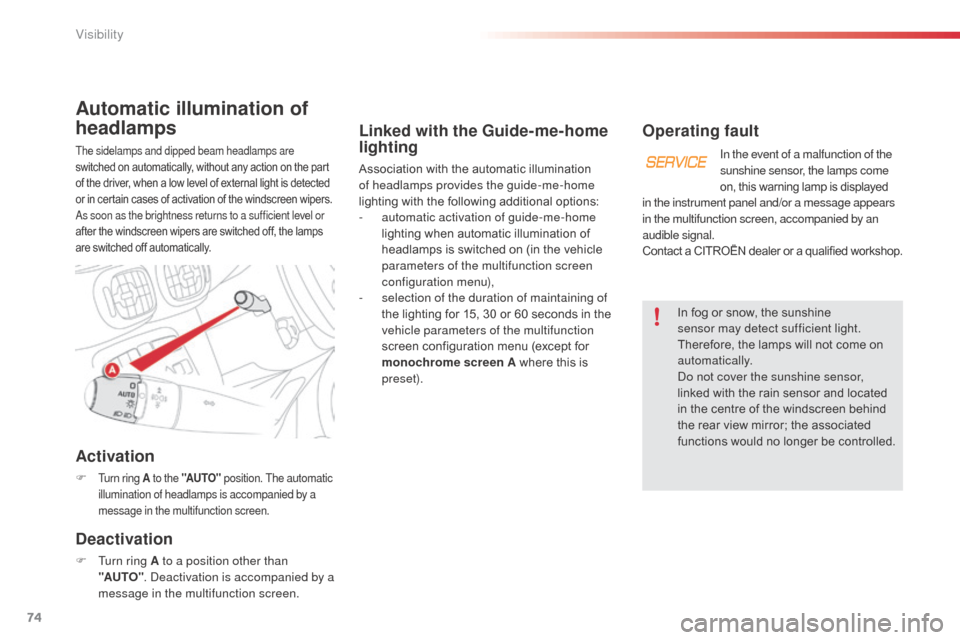
74
Linked with the Guide-me-home
lighting
Association with the automatic illumination
of headlamps provides the guide-me-home
lighting with the following additional options:
-
a
utomatic activation of guide-me-home
lighting when automatic illumination of
headlamps is switched on (in the vehicle
parameters of the multifunction screen
configuration menu),
-
s
election of the duration of maintaining of
the lighting for 15, 30 or 60 seconds in the
vehicle parameters of the multifunction
screen configuration menu (except for
monochrome screen A where this is
preset).
Operating fault
In the event of a malfunction of the
sunshine sensor, the lamps come
on, this warning lamp is displayed
in the instrument panel and/or a message appears
in the multifunction screen, accompanied by an
audible signal.
Contact a CITROËN dealer or a qualified workshop.
In fog or snow, the sunshine
sensor may detect sufficient light.
Therefore, the lamps will not come on
automatically.
Do not cover the sunshine sensor,
linked with the rain sensor and located
in the centre of the windscreen behind
the rear view mirror; the associated
functions would no longer be controlled.
Automatic illumination of
headlamps
The sidelamps and dipped beam headlamps are
switched on automatically, without any action on the part
of the driver, when a low level of external light is detected
or in certain cases of activation of the windscreen wipers.
As soon as the brightness returns to a sufficient level or
after the windscreen wipers are switched off, the lamps
are switched off automatically.
Activation
F Turn ring A to the "AUTO" position. The automatic
illumination of headlamps is accompanied by a
message in the multifunction screen.
Deactivation
F Turn ring A to a position other than "AUTO" . Deactivation is accompanied by a
message in the multifunction screen.
Visibility
Page 82 of 296
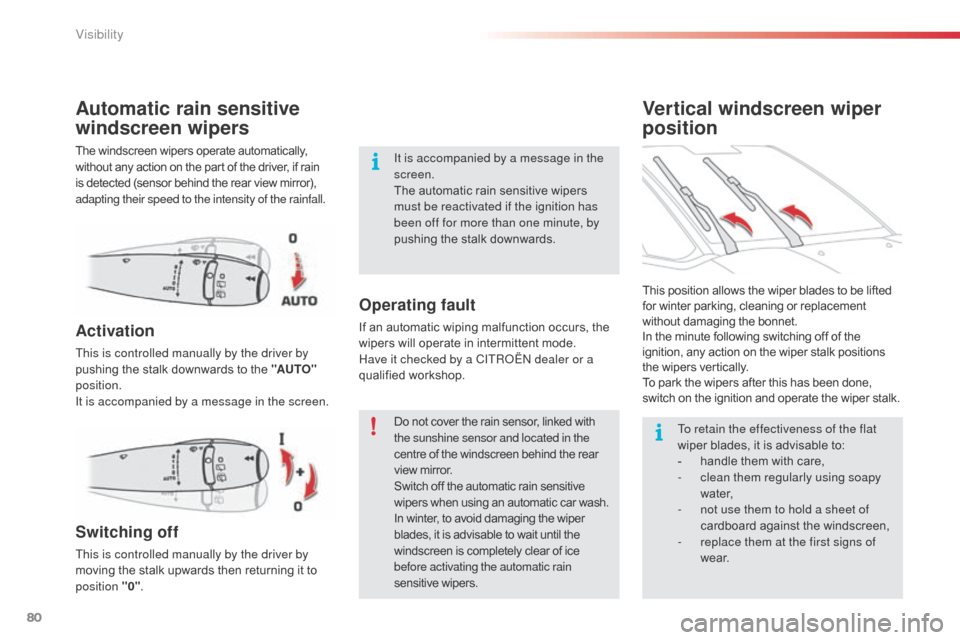
80
Vertical windscreen wiper
position
Automatic rain sensitive
windscreen wipers
The windscreen wipers operate automatically,
without any action on the part of the driver, if rain
is detected (sensor behind the rear view mirror),
adapting their speed to the intensity of the rainfall.
Activation
This is controlled manually by the driver by
pushing the stalk downwards to the "AUTO"
position.
It is accompanied by a message in the screen. This position allows the wiper blades to be lifted
for winter parking, cleaning or replacement
without damaging the bonnet.
In the minute following switching off of the
ignition, any action on the wiper stalk positions
the wipers vertically.
To park the wipers after this has been done,
switch on the ignition and operate the wiper stalk.
Switching off
This is controlled manually by the driver by
moving the stalk upwards then returning it to
position "0"
.
Operating fault
If an automatic wiping malfunction occurs, the
wipers will operate in intermittent mode.
Have it checked by a CITROËN dealer or a
qualified workshop.It is accompanied by a message in the
screen.
The automatic rain sensitive wipers
must be reactivated if the ignition has
been off for more than one minute, by
pushing the stalk downwards.
Do not cover the rain sensor, linked with
the sunshine sensor and located in the
centre of the windscreen behind the rear
view mirror.
Switch off the automatic rain sensitive
wipers when using an automatic car wash.
In winter, to avoid damaging the wiper
blades, it is advisable to wait until the
windscreen is completely clear of ice
before activating the automatic rain
sensitive wipers.
To retain the effectiveness of the flat
wiper blades, it is advisable to:
-
h
andle them with care,
-
c
lean them regularly using soapy
water,
-
n
ot use them to hold a sheet of
cardboard against the windscreen,
-
r
eplace them at the first signs of
w e a r.
Visibility
Page 110 of 296
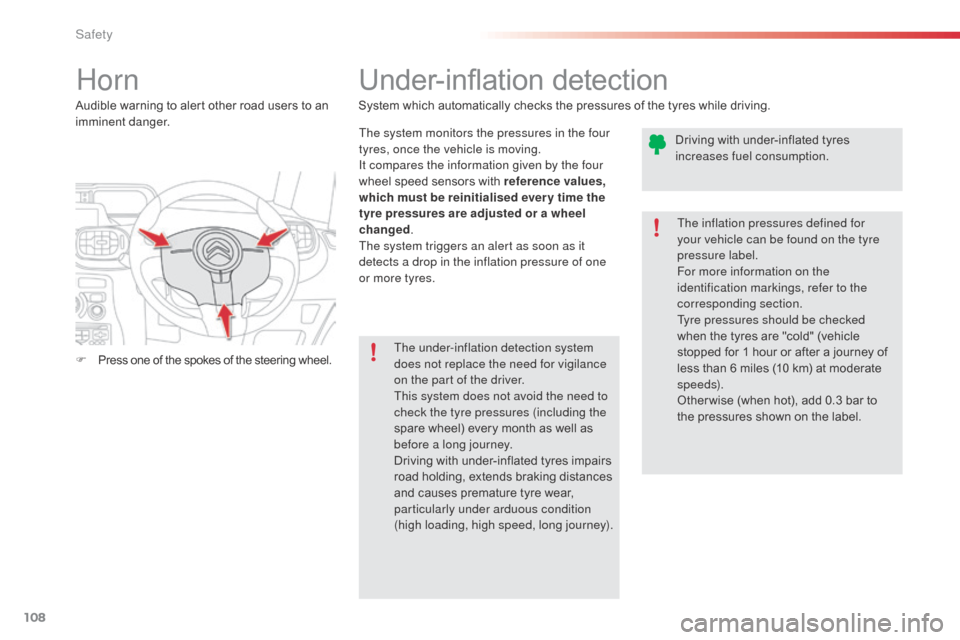
108
Horn
F Press one of the spokes of the steering wheel. Audible warning to alert other road users to an
imminent danger.
Under-inflation detection
System which automatically checks the pressures of the tyres while driving.The system monitors the pressures in the four
tyres, once the vehicle is moving.
It compares the information given by the four
wheel speed sensors with reference values,
which must be reinitialised ever y time the
tyre pressures are adjusted or a wheel
changed .
The system triggers an alert as soon as it
detects a drop in the inflation pressure of one
or more tyres.
The under-inflation detection system
does not replace the need for vigilance
on the part of the driver.
This system does not avoid the need to
check the tyre pressures (including the
spare wheel) every month as well as
before a long journey.
Driving with under-inflated tyres impairs
road holding, extends braking distances
and causes premature tyre wear,
particularly under arduous condition
(high loading, high speed, long journey). The inflation pressures defined for
your vehicle can be found on the tyre
pressure label.
For more information on the
identification markings, refer to the
corresponding section.
Tyre pressures should be checked
when the tyres are "cold" (vehicle
stopped for 1 hour or after a journey of
less than 6 miles (10 km) at moderate
speeds).
Other wise (when hot), add 0.3 bar to
the pressures shown on the label.
Driving with under-inflated tyres
increases fuel consumption.
Safety
Page 138 of 296
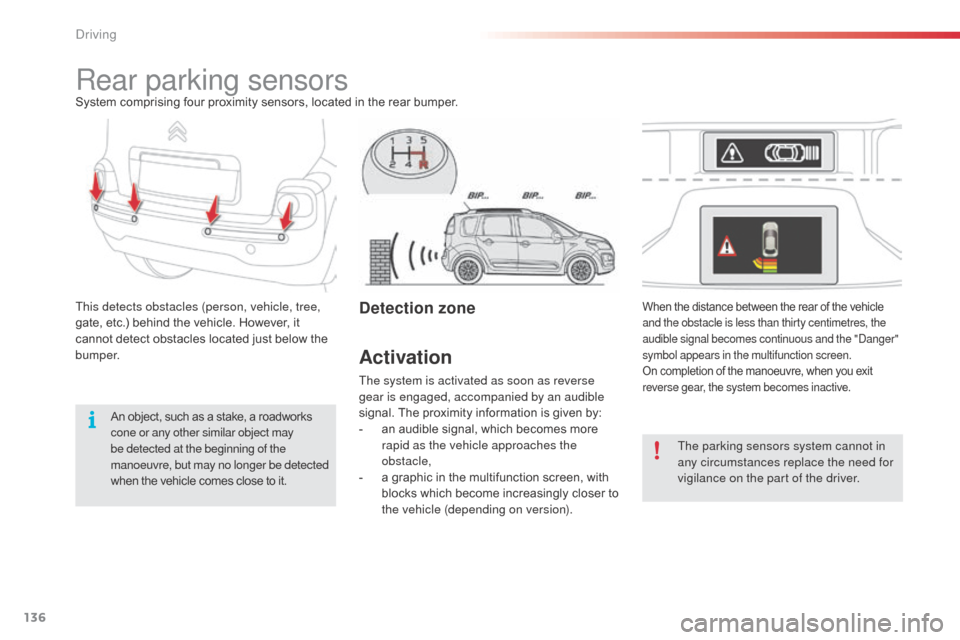
136
Rear parking sensorsSystem comprising four proximity sensors, located in the rear bumper.
This detects obstacles (person, vehicle, tree,
gate, etc.) behind the vehicle. However, it
cannot detect obstacles located just below the
b u m p e r.
Activation
The system is activated as soon as reverse
gear is engaged, accompanied by an audible
signal. The proximity information is given by:
-
a
n audible signal, which becomes more
rapid as the vehicle approaches the
obstacle,
-
a g
raphic in the multifunction screen, with
blocks which become increasingly closer to
the vehicle (depending on version).
Detection zoneWhen the distance between the rear of the vehicle
and the obstacle is less than thirty centimetres, the
audible signal becomes continuous and the "Danger"
symbol appears in the multifunction screen.
On completion of the manoeuvre, when you exit
reverse gear, the system becomes inactive.
An object, such as a stake, a roadworks
cone or any other similar object may
be detected at the beginning of the
manoeuvre, but may no longer be detected
when the vehicle comes close to it. The parking sensors system cannot in
any circumstances replace the need for
vigilance on the part of the driver.
Driving